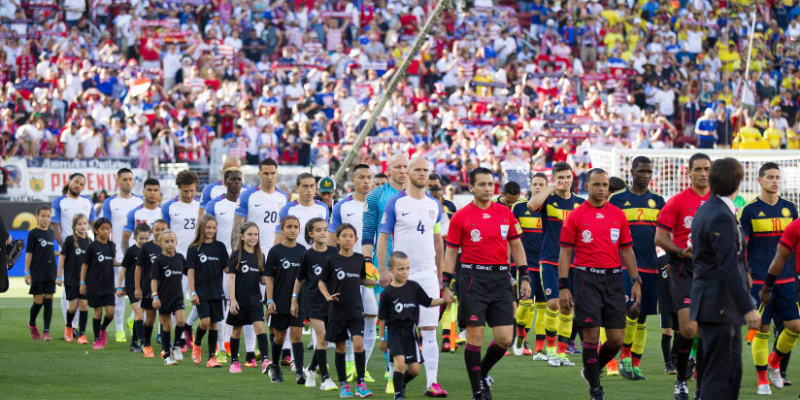The answer is yes — the United States can play in the Copa América, but only under special circumstances. Because the U.S. is a member of CONCACAF (North, Central America and Caribbean football) and not CONMEBOL (South America), the USMNT must either be invited or qualify via a special agreement to participate. In this article, KMSoccer will walk you through how and why the U.S. have (and haven’t) played in Copa América, their historical performance, and what the future might hold for their participation.
Why the USA Aren’t a Regular Copa América Team

The Copa América is South America’s premier men’s national team tournament, organized by CONMEBOL. Historically it was reserved for South American nations, but because CONMEBOL only has ten member countries, guest teams have been invited regularly since 1993.
The United States is part of CONCACAF, and unless CONMEBOL explicitly invites or includes them through a cooperative format, the U.S. does not automatically qualify to enter the tournament.
Invitations or special qualification paths are thus essential for the U.S. The process has varied over time, including automatic entries when hosting, direct invitations, or qualification through tournaments like the CONCACAF Nations League.
U.S. History in Copa América: A Rollercoaster Ride

The U.S. first appeared in the Copa América in 1993 and has since participated in 1995, 2007, 2016 (Centenario) and 2024.
- 1993: The U.S. entered as a guest in Ecuador and were eliminated in the group stage, finishing with one draw and two losses.
- 1995: In Uruguay, the U.S. enjoyed a strong run, finishing in fourth place after making the semi-finals and losing the third-place match.
- 2007: In Venezuela, the U.S. struggled. They lost all three group matches and failed to advance.
- 2016 (Centenario): As co-hosts of Copa América Centenario in the U.S., the American team made a strong showing, finishing in fourth place after a semifinal loss to Argentina and falling short in the third-place playoff.
- 2024: The U.S. returned to the tournament hosted at home under a new format. However, unlike in 2016, they did not have automatic entry this time and had to qualify. Despite opening with a 2-0 win over Bolivia, they were eliminated in the group stage after losses to Panama and Uruguay.
To date, the United States has never won the Copa América. Their best Copa runs—1995 and 2016—both ended in fourth place.
How Did the 2024 Qualification Work?

The 2024 Copa América, held in the United States, was organized under a joint CONMEBOL-CONCACAF strategic framework. Unlike the Centenario tournament, the U.S. did not receive an automatic berth just for hosting. Instead, the U.S. qualified by winning in the 2023–24 CONCACAF Nations League League A quarterfinals—defeating Trinidad and Tobago on aggregate.
There were six CONCACAF slots for the 2024 Copa América, allocated through Nations League results. This arrangement represents a shift in how guest teams are selected, moving away from direct invitations to performance-based qualification for North American teams.
Even though the U.S. were hosts, they earned their spot on merit rather than by default—underscoring the tournament’s increasing competitiveness and the desire to give CONCACAF nations a fair shot at entry.
What Makes U.S. Copa América Appearances Different?
Exposure to South American competition
When the U.S. plays in Copa América, they gain exposure to South American giants—teams like Argentina, Brazil, Uruguay, and Colombia—and a different style of football than they usually face in CONCACAF tournaments. These games test the squad’s adaptability, tactical flexibility, and mental fortitude.
Learning, and Eric Wynalda encountered world-class talent, which they later cited as integral to their development. The 2016 and 2024 tournaments offered the current generation—Pulisic, McKennie, Balogun—real-time challenges and growth opportunities on a bigger stage.
The pressure of playing at home
Hosting Copa América brings high expectations—but also heightened pressure. In 2016, the U.S. leveraged the home crowd and atmosphere to push deep into the tournament. However, playing at home in 2024 did not guarantee success, as U.S. Soccer experienced a group-stage exit despite playing in front of home fans.
Qualification vs. Invitation
The shift from “invited guests” to qualification via Nations League represents a dee. participation is now more performance-based rather than reliant on CONMEBOL’s goodwill, which in turn raises the competitive bar and stakes for North American teams.
Can the U.S. Be a Permanent Copa América Participant?
The idea of the United States—or other CONCACAF teams—becoming regular Copa América participants has been floated for years. But several obstacles remain:
- CONMEBOL membership: The U.S. would have to join CONMEBOL or negotiate a permanent place in Copa América, which is structurally unlikely because the tournament is intended for South American federations.
- Tournament format: Copa América formats and scheduling vary, and permanent inclusion of non-CONMEBOL teams would require major shifts—including balancing confederations, scheduling, and qualification.
- Qualification metrics: If U.S. participation depends on the CONCACAF Nations League or other qualifying lenses, then consistency becomes essential. The U.S. must secure good results well ahead of time.
- Commercial and logistical interests: Hosting Copa América in the United States is lucrative—and CONMEBOL has an interest in maintaining competitive integrity. Making the U.S. a regular entrant could change how the tournament negotiates participation, TV rights, and hosting.
In short, while the United States can play in Copa América—and has done so several times—it is unlikely to become a permanent fixture unless major changes are made to tournament structure or CONMEBOL membership rules. For now, invitations and performance-based qualification remain the gateway.
Key Stats: U.S. Copa América Performance
- Total Copa América appearances: 5 (1993, 1995, 2007, 2016, 2024)
- Best finishes: Fourth place (1995, 2016)
- All-time record in Copa América: 21 matches, 6 wins, 2 draws, 13 losses, 21 goals for, 32 against
- Top U.S. goal scorers in Copa América: Eric Wynalda, Clint Dempsey, and Folarin Balogun
- Notable players with most Copa América appearances for the U.S.: Tab Ramos, Cobi Jones, Alexi Lalas all made 9 appearances between 1993 and 1995.
What Copa América Means for the USMNT
For the U.S. Men’s National Team, participating in Copa América brings both prestige and pressure. It serves as a reality check—a stage to test tactical maturity and mental strength against footballing powerhouses in a way that the Gold Cup or CONCACAF tournament often cannot. Strong performances can accelerate team development, build confidence, and contribute to long-term planning for tournaments like the World Cup. But failures—especially when hosted at home—can highlight structural issues, raise questions about coaching, and put scrutiny on player development paths.
In 2024, the U.S. experienced both sides of that coin: an encouraging win over Bolivia and a disappointing group-stage exit after losses to Panama and Uruguay. That split result reflected the tightrope walk of progress and setbacks that the USMNT often faces on big stages.
Conclusion
Can USA play in Copa America? Yes — but solely through special invitations or qualification, not as automatic entrants. The U.S. has participated in five Copa América editions so far, with its best results being two fourth-place finishes, but has never won the tournament. Their participation has often been episodic, shaped by cooperative CONMEBOL-CONCACAF arrangements or home-tournament scenarios rather than permanent membership.
For fans who want to follow U.S. Copa América journeys, uncover detailed match stats, review historic performances, or learn what these appearances mean for the World Cup and beyond, keep checking KMSoccer. Want a breakdown of the USMNT’s matches in Copa América 2024, or a head-to-head analysis vs. South American teams like Argentina and Uruguay? Just say the word — and KMSoccer will bring it live.







